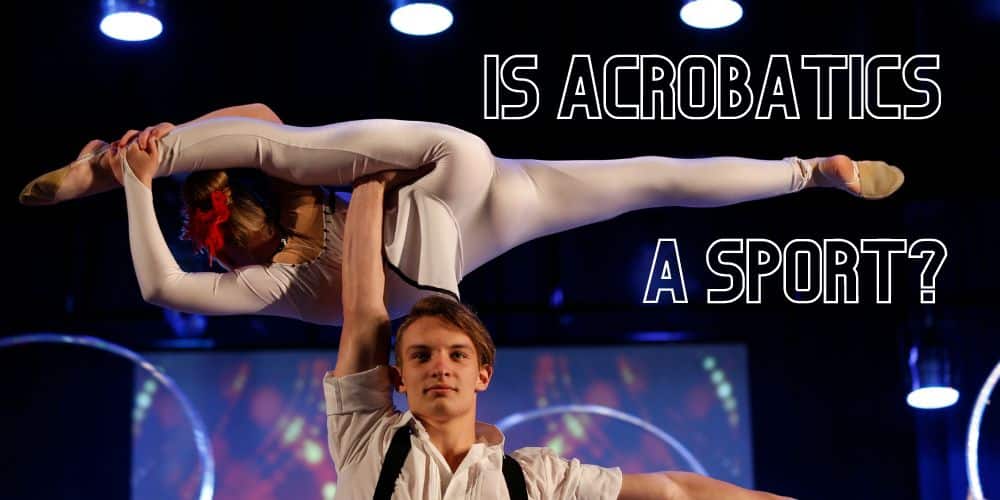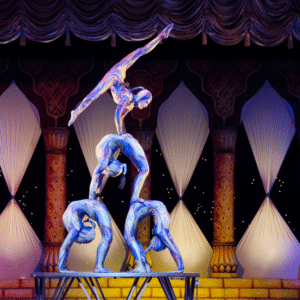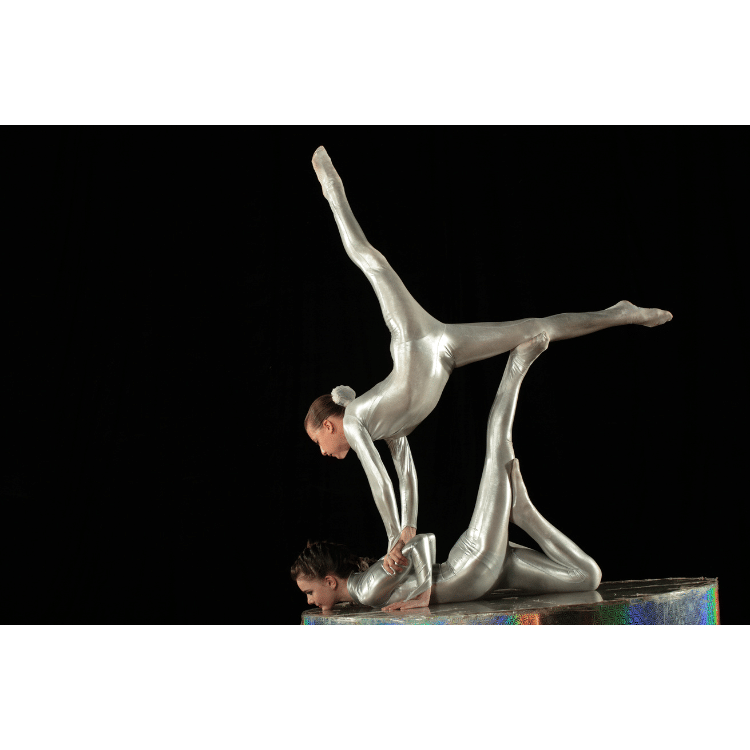
Is Acrobatics a sport? This question often creates strong debate and touches on the competitive format and scoring systems of a traditionally artistic and creative discipline.
Dive into our guide to explore the intricate world where physical prowess meets graceful performance and discover what makes acrobatics a sport.
What is acrobatic gymnastics?
Acrobatic gymnastics is a competitive sport in which acrobatics, dance, and tumbling are performed in combination with elements of gymnastics, performed by usually by pairs or trios of gymnasts. It requires high levels of balance compared to other gymnastics disciplines.

Acrobatic routines involve different types of balances as a group or pair. Gymnasts are referred to as bases or tops and use each other to perform a balance with skill and precision.
Sports Acrobatics is governed by a set of rules known as the Code of Points, which is updated every four years in alignment with the Olympic cycle. Acrobatic gymnastics features in international competitions such as the World Games, European Games, and has its own Acrobatic Gymnastics World Championships.
The sport requires athletes to perform a combination of balance (static moves), dynamic (acrobatic moves involving flight), and combined routines that incorporate elements of both balance and dynamic moves
For example, a top could hold a handstand whilst balancing on the base’s head or shoulders. This makes Acrobatic Gymnastics distinctly different to all of the other disciplines. Routines are performed to music and judges will score based on the difficulty levels of skills and the execution of the performance.
Is Acrobatics a Sport?
Acrobatics is often considered both an art form and a sport, depending on the context in which it is performed. In artistic settings, such as circuses or theatrical performances, acrobatics is typically viewed more as an art. In these environments, the focus is on expression, storytelling, and aesthetics rather than competitive achievement.

However, acrobatics also exists in a sports context, where it is usually subjected to formal rules, scoring systems, and competitive events. For example, acrobatic gymnastics is a competitive gymnastic discipline where partnerships of gymnasts perform routines consisting of acrobatic moves, dance, and tumbling, set to music.
There are also various competitions at national and international levels, including the World Championships, that specifically focus on acrobatic performance as a sport.
Moreover, acrobatic elements are integral to various other sports, such as diving, trampolining, and even some martial arts, further solidifying its role within the realm of competitive activities.
So, acrobatics can indeed be considered a sport, particularly when it involves competitive elements, rigorous training, and a focus on physical prowess and skill.
Why is Acrobatics not a Sport?
Some people don’t consider Acrobatics to be a sport for a number of reasons.

Acrobatics competitions are similar to gymnastics due to the role of judges in the scoring routines. Whilst there are strict guidelines for judges to follow there is always a chance that a judge can be biased in their scoring. In some peoples view this undermines the ability for acrobatics to be a sport in the same way as Football or Basketball.
In addition to Acrobatics and Gymnastics there are other sports which use judges to score.
- Figure Skating
- Dance
- Sports Aerobics
- Trampoline
Is Acrobatics an Olympic Sport?
Acrobatics (Acro) is not currently an Olympic sport because it is not one of the events included in the program of the Olympic Games. The International Olympic Committee (IOC) periodically reviews and updates the program of events and new sports can be added or existing sports can be dropped.
Currently, the gymnastics disciplines competed at the Olympics are Artistic Gymnastics, Rhythmic Gymnastics and Trampoline Gymnastics. Even within each of these disciplines, there are a number of events with medals awarded for each. For example, Women’s Artistic gymnastics comprises All-Around and individual competitions on the Floor, Vault, Asymmetric Bars and Balance Beam.
The International Olympic Committee (IOC) selects new sports for the Olympics through a proposal and review process. Interested sports organizations can submit a proposal to the IOC to have their sport added to the Olympic program. The IOC then evaluates the proposal based on criteria such as the sport’s global popularity, universality, and the number of countries with a high level of participation in the sport.
If the sport meets the criteria, it will be considered for inclusion in the Olympic program. The final decision on new sports is made by the IOC during its Session, which is held every two years.
Will acrobatic gymnastics ever be in the Olympics?
The International Olympic Committee (IOC) has certain factors to take into account when deciding which events are included in an upcoming Olympiad.
- The balance between male and female participants
- Logistics of scheduling all events within a given time frame
- The quota of events within a specific sport
The existing Olympic gymnastics schedule makes it very difficult for any further gymnastics events to be added. So it is very unlikely that Acrobatics will be in the Olympics in the near future.
Will acrobatics be at Paris 2024?
The FIG made a proposal to the IOC to include Acrobatic Gymnastics, Aerobic Gymnastics and Parkour at Paris 2024 but all were rejected due to the restrictions on logistics and quotas for gymnastics.
So Acrobatic Gymnastics will not be at Paris 2024.
Parkour however will be included in non-competitive demonstration events around Paris. This is due to Paris being the birthplace of Parkour.
Given the IOC’s desire to keep the Olympics relevant for a younger audience, it would be fair to say that Parkour probably has the best chance of becoming an Olympic sport before any of the other gymnastic disciplines including acrobatics.
Is acrobatic gymnastics popular?
Acrobatic gymnastics has a moderate level of popularity, with dedicated competitive circuits and national and international events. It has a growing following, especially among young gymnasts, but is not as widely known or followed as other gymnastics disciplines like artistic gymnastics.
The pinnacle of acrobatic gymnastics is the world championships and has often been dominated by Russia, China, Ukraine and Bulgaria.
Many high-level acrobats pursue a career in the circus after retirement. Cirque de Soleil employs many acrobats making it a lucrative source of income for those that are chosen. However, acrobatics lacks the mainstream media exposure of Artistic gymnastics, especially in the USA.
This is a factor that will prevent acrobatic gymnastics from replacing one of the existing gymnastics events at the Olympics.
Final Thoughts
Acrobatics should be considered a sport in the same way artistic gymnastics is. The existing gymnastics program at the Olympics is extremely popular with TV viewers so it’s hard to see the IOC withdrawing an event and replacing it with acrobatics or any other event.
Until the quota for gymnastics is increased at the Olympics, Acrobatics will continue to be a non-Olympic sport, but a definitely a sport nonetheless.
FAQs
What do you call a person who does Acrobatics?
An Acrobat is a person who does Acrobatics.
Why do people like acrobatics?
People like Acrobatics because of it’s visual appeal. The balances are often intricate and precise and require years of practice. The routines are stunning to watch and this is why people like Acrobatics.
Is acrobatics Greek or Latin?
Acrobatics comes from the Greek ‘Acro’ which means extreme. ‘Bates’ means walk or move.
How many types of acrobatics are there?
In gymnastics acrobatics is usually referred to as Sports Acrobatics, Sports Acro or Acro Gymnastics or just Acro for short. However, in the wider community there is also Acro Yoga and Acro Dance.
- How to Do a Back Handspring: Complete Step-by-Step GuideLearning how to do a back handspring is an exciting milestone for any gymnast. It builds confidence, agility, and forms the foundation for advanced tumbling… Read more: How to Do a Back Handspring: Complete Step-by-Step Guide
- How To Get Over a Mental Block In Gymnastics: A Complete GuideGymnastics is a sport that requires not only physical strength and skill but also mental strength. When a gymnast feels like they cannot attempt a… Read more: How To Get Over a Mental Block In Gymnastics: A Complete Guide
- The Best Leotard for Girls in 2025: What to Look ForFinding an ideal leotard for girls isn’t just about picking a dazzling design that sparkles (although it does help!). The leotard has to fit perfectly,… Read more: The Best Leotard for Girls in 2025: What to Look For
- The Best Gymnastics Shorts (Our Top Picks)The best gymnastics shorts are designed to be worn over the top of a leotard providing additional coverage around the upper legs, whilst allowing gymnasts… Read more: The Best Gymnastics Shorts (Our Top Picks)
- Decathlon Leotards – Are They Any Good?If you’re in the market for a new leotard, you may be wondering if Decathlon leotards are any good considering the low cost of their… Read more: Decathlon Leotards – Are They Any Good?
- A Complete Guide to Gymnastics Hand RipsAre you tired of dealing with painful gymnastics rips on your hands from training? Look no further – this article offers a comprehensive approach to… Read more: A Complete Guide to Gymnastics Hand Rips






